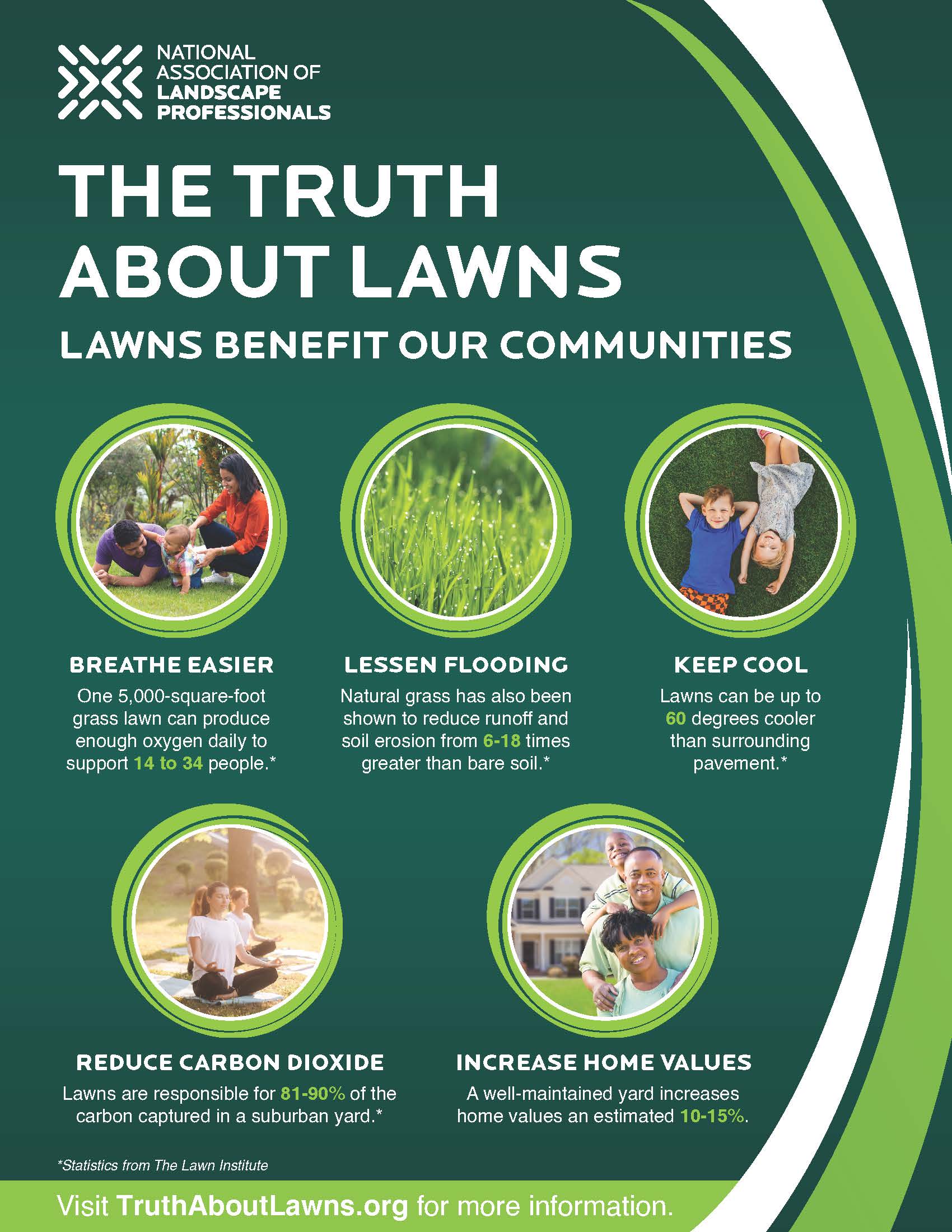How Lawns Benefit Our Communities

Lawns are seemingly everywhere and while you may them for granted, they're actually hard-working members of an ecosystem benefitting urban and suburban spaces in multiple ways. If lawns were eliminated, climate change challenges would significantly increase, including higher air temperatures, more carbon dioxide in the atmosphere, and less oxygen. Lawns are surprisingly good at capturing rain; without them rainfall would run off instead of infiltrating the ground, increasing flooding. Lawns also capture a wide variety of environmental pollutants, so without them there would be more air pollution.
"It’s interesting how little most people know about the environmental benefits of natural grass lawns and green spaces," said Britt Wood, CEO, National Association of Landscape Professionals. "People have long known about benefits of trees — but less about the benefits their lawns deliver."
How lawns benefit your environment
Here are facts from The Lawn Institute you might not know about how grass lawns contribute to the well-being of neighborhoods and communities.
1. Breathe easier: One 5,000-square-foot grass lawn can produce enough oxygen daily to support 14 to 34 people.
2. Reduce carbon dioxide: Tackling climate change involves finding a place to store carbon from the atmosphere. Carbon modeling of a suburban home on a half-acre lot, with landscape beds, shrubs, trees and a grass lawn, indicates the lawn is responsible for 81-90% of the carbon captured. And in a recent study of a typical metropolitan area, low- and medium-density residential lots accounted for over 50% of carbon captured in urban green spaces.
3. Keep cool: You’ve probably done it yourself – walking barefoot on an asphalt street in the summer can be painfully hot. Where did you go to find relief? Without thinking about it, you probably headed for the nearest lawn. Lawns can be up to 60 degrees cooler than surrounding pavement. Plants, including natural turfgrass, act like air conditioners due to a naturally occurring cooling process known as evapotranspiration.
4. Lessen flooding: Lawns naturally provide excellent water filtration, sediment reduction, runoff control, flood control and pollutant reduction. Natural grass has also been shown to reduce runoff and soil erosion from 6-18 times greater than bare soil.
5. Increase home values: Aesthetics matter. A well-maintained lawn increases home values an estimated 10-15%, and a consumer survey by the NALP found 79% of Americans believe a lawn is an important feature when renting or buying a home.
From battery-powered mowers and irrigation with smart sensors that detect rainfall to soil sensors and more, today's lawn care practices are evolving to be more sustainable in caring for backyard and neighborhood green spaces, so they'll provide even greater environmental benefits.
Common myths about lawns
Still on the fence about natural grass? Here are some facts that set the record straight about some lawn myths.
Myth: Lawns are a monoculture.
Fact: Not true. The average lawn contains a variety of species of grasses, plants and weeds.
Myth: Lawns don’t support biodiversity.
Fact: The soil underneath lawns teems with life: as many as 52 different arthropod families, 28 genera of nematodes plus a complex network of micro-organisms.
Myth: Lawns use too much water.
Fact: Most suburban homes don’t use irrigation (only 37% of new homes in 2020 were built with irrigation systems, according to the Irrigation Association). Many lawns in non-arid areas get much or all needed moisture from rainwater. In addition, turfgrass researchers have been developing new varieties requiring little to no additional water.
Myth: Lawns are a waste of time and resources.
Fact: According to a survey by the NALP, 79% of Americans say having a lawn is important to them. Working and playing in yards reduces stress and encourages physical activity, and doctors agree that fresh air, sunshine and exercise are beneficial for physical and mental health.
Myth: Lawn pesticides are unsafe.
Fact: Pesticides are among the most rigidly regulated commodities in the U.S., undergoing a rigorous approval process by the EPA that often takes over a decade. According to the Responsible Industry for a Sound Environment, 77% of Americans are not opposed to residential pesticide use, because they want to protect their families from invasive species and diseases caused by insects.
Stewarding local green spaces is vital
The U.S. is a vast country with many different climates. In areas with adequate rainfall, lawns comprise a valuable part of the environment. Where water is scarce, however, chosen plants and grasses should be drought-resistant and well-adapted to thrive in local conditions. If towns and cities have fewer green spaces, residents will struggle with rainwater runoff issues and heat island effects, highlighting the need for appropriate green space management nationwide.
"The more people know about the environmental benefits of green spaces in their communities, the better equipped they are to make good choices about prioritizing their care," concluded Wood.



